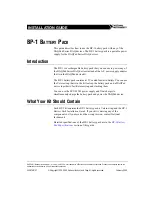
InstructIon manual for
:
start
starter/chargers
IMPORTANT:
PLEasE rEaD tHEsE INstrUCtIONs CarEFULLY. NOtE tHE saFE OPEratIONaL rEQUIrEMENts, WarNINGs aND CaUtIONs. UsE tHIs
PrODUCt COrrECtLY aND WItH CarE FOr tHE PUrPOsE FOr WHICH It Is INtENDED. FaILUrE tO DO sO MaY CaUsE DaMaGE aND/Or PErsONaL
INJUrY aND WILL INVaLIDatE tHE WarraNtY. PLEasE rEtaIN tHEsE INstrUCtIONs FOr FUtUrE UsE.
thank you for purchasing a sealey product. manufactured to a high standard this product will give you years of trouble free performance if these instructions are
carefully followed and the product is correctly maintained.
start180, start240, start360, start560
1. saFEtY INstrUCtIONs
1.1.
ELECtrICaL saFEtY
IMPOrtaNt!
small battery chargers are supplied with plugs fitted. starter/chargers, however, can draw more than 13amps from
the mains supply when being used to crank large engines. for this reason starter/chargers are not supplied with a fitted plug. We
recommend that for maximum performance your starter/charger is plugged into a 30amp electrical supply, and further recommend
that you consult an electrician in order to fit an appropriate plug.
the following statements on electrical safety must also be read and understood before using the starter/charger.
WarNING! It is the user’s responsibility to check the following:
You must check all electrical equipment and appliances to ensure they are safe before using. You must inspect power supply leads,
plugs and all electrical connections for wear and damage. You must ensure the risk of electric shock is minimised by the installation
of appropriate safety devices. an rccB (residual current circuit Breaker) should be incorporated in the main distribution board.
We recommend that an rcD (residual current Device) is used with all electrical products. It is particularly important to use an rcD
with portable products that are plugged into an electrical supply not protected by an rccB. If in doubt consult a qualified electrician.
You may obtain a residual current Device by contacting your sealey dealer. You must also read and understand the following
instructions concerning electrical safety.
1.1.1.
the electricity at Work act 1989 requires all portable electrical appliances, if used on business premises, to be tested by a qualified
person, using a Portable appliance tester (Pat), at least once a year.
1.1.2.
the health & safety at Work act 1974 makes owners of electrical appliances responsible for the safe condition of the appliance and
the safety of the appliance operator. If in any doubt about electrical safety, contact a qualified electrician.
1.1.3.
DO
ensure the insulation on all cables and the product itself is safe before connecting to the mains power supply. see 1.1.2. above
and use a Portable appliance tester (Pat).
1.1.4.
DO
ensure that cables are always protected against short circuit and overload.
1.1.5.
DO
regularly inspect power supply, leads, plugs for wear and damage and all electrical connections to ensure that none are loose.
1.1.6.
DO
check that the voltage marked on the product is the same as the electrical power supply
to be used and check that all fused plugs are fitted with the correct rating of fuse.
1.1.7.
DO NOt
pull or carry the powered appliance by its power supply lead and do not pull the
plug by the cable. Products must not be pulled or carried by their output cables.
1.1.8.
DO NOt
use worn or damage leads, plugs or connections. Immediately replace or repair
by qualified persons.
1.1.9.
We do not recommend the use of an extension cable with the charger as the power output
may be seriously reduced.
1.1.10. subject to 1.1. above, the following instruction is for fitting a 13amp plug since this will be
adequate for use when charging and when starting engines in small vehicles.
no responsibility is accepted in the event that the product is misused and/or used with a
13 amp plug when a 30amp supply is required.
a) Connect the green/yellow earth wire to the earth terminal ‘E’.
b) Connect the brown live wire to live terminal ‘L’.
c) Connect the blue neutral wire to the neutral terminal ‘N’.
d) After wiring, check that there are no bare wires, that all wires have been
correctly connected, that the external insulation extends beyond the cable restraint and that the restraint is tight.
1.2.
PErsONaL PrECaUtIONs
ensure there is another person within hearing range of your voice and close enough to come to your
aid, should a problem arise when working near a lead-acid battery.
Wear safety eye protection and protective clothing. avoid touching eyes while working near battery.
have fresh water and soap nearby in case battery acid contacts skin, clothing or eyes.
Wash immediately with soap and water if battery acid contacts skin or clothing. If acid enters eye, flush eye immediately with cool, clean
running water for at least 15 minutes and seek immediate medical attention.
remove personal metallic items such as rings, bracelets, necklaces and watches. a lead-acid battery can produce a short-circuit
current high enough to weld a ring or the like to metal, which would cause severe burns.
ensure hands, clothing (especially belts) are clear of fan blades and other moving or hot parts of engine, remove ties and contain
long hair.
DO NOt
smoke or allow a spark or flame in the vicinity of battery or engine.
DANGER! BE AWARE, LEAD-ACID BATTERIES GENERATE EXPLOSIVE GASES DURING NORMAL BATTERY
OPERATION. FOR THIS REASON, IT IS VERY IMPORTANT TO READ AND FOLLOW THESE INSTRUCTIONS CAREFULLY,
EACH TIME YOU USE THE STARTER/CHARGER.
Follow these instructions and those published by the battery and vehicle manufacturers and the manufacturer of any equipment
you intend to use in the vicinity of the battery. Remember to review warning marks on all products and on engines.
rECOMMENDED FUsE ratING 13 aMP
Blue
Neutral
Wire
Yellow & Green
Earth Wire
Cable
Restraint
Brown
Live
Wire
Original Language Version
start180, 240, 360, 560 Issue: 1 - 09/08/11






















